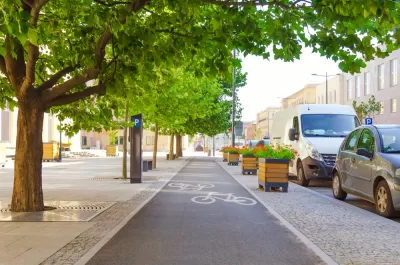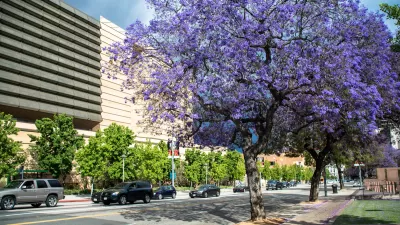New research shows a strong connection between a healthy urban tree canopy and lowered mortality rates.

It’s no surprise that street trees benefit public health, but a new study shows a “direct statistical connection” between street trees and reduced mortality rates. Robert Steuteville explains the research in an article for Congress for the New Urbanism.
To be sure, association is correlation, and correlation is not causation. And yet the study controlled for such factors as race, education, income, age, and year of planting in the analysis of tree plantings and people in Portland, Oregon, census tracts. Importantly, researchers were able to control for demographic causes for the health benefits, which strengthens the case for street trees being a critical factor.
Important findings include that “Tree plantings were significantly associated with reductions in non-accidental and cardiovascular mortality,” with bigger, older trees having a stronger connection than younger ones.
The study focused on street trees rather than trees in private gardens, which are easier to monitor, are “a uniquely visible type of tree that, a priori, we would expect to have a broader neighborhood-level impact on health,” and can be planted through public initiatives.
FULL STORY: The life-saving benefits of street trees

Maui's Vacation Rental Debate Turns Ugly
Verbal attacks, misinformation campaigns and fistfights plague a high-stakes debate to convert thousands of vacation rentals into long-term housing.

Planetizen Federal Action Tracker
A weekly monitor of how Trump’s orders and actions are impacting planners and planning in America.

In Urban Planning, AI Prompting Could be the New Design Thinking
Creativity has long been key to great urban design. What if we see AI as our new creative partner?

Florida Seniors Face Rising Homelessness Risk
High housing costs are pushing more seniors, many of them on a fixed income, into homelessness.

Massachusetts Budget Helps Close MBTA Budget Gap
The budget signed by Gov. Maura Healey includes $470 million in MBTA funding for the next fiscal year.

Milwaukee Launches Vision Zero Plan
Seven years after the city signed its Complete Streets Policy, the city is doubling down on its efforts to eliminate traffic deaths.
Urban Design for Planners 1: Software Tools
This six-course series explores essential urban design concepts using open source software and equips planners with the tools they need to participate fully in the urban design process.
Planning for Universal Design
Learn the tools for implementing Universal Design in planning regulations.
Gallatin County Department of Planning & Community Development
Heyer Gruel & Associates PA
JM Goldson LLC
City of Camden Redevelopment Agency
City of Astoria
Transportation Research & Education Center (TREC) at Portland State University
Jefferson Parish Government
Camden Redevelopment Agency
City of Claremont





























